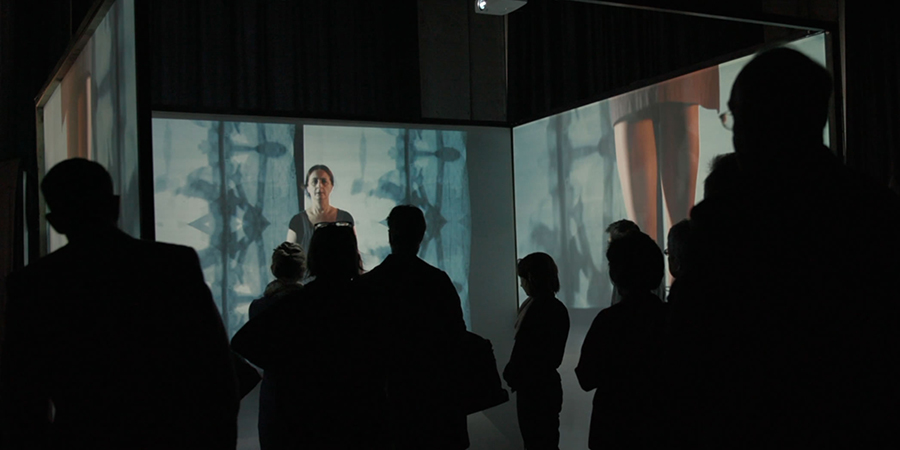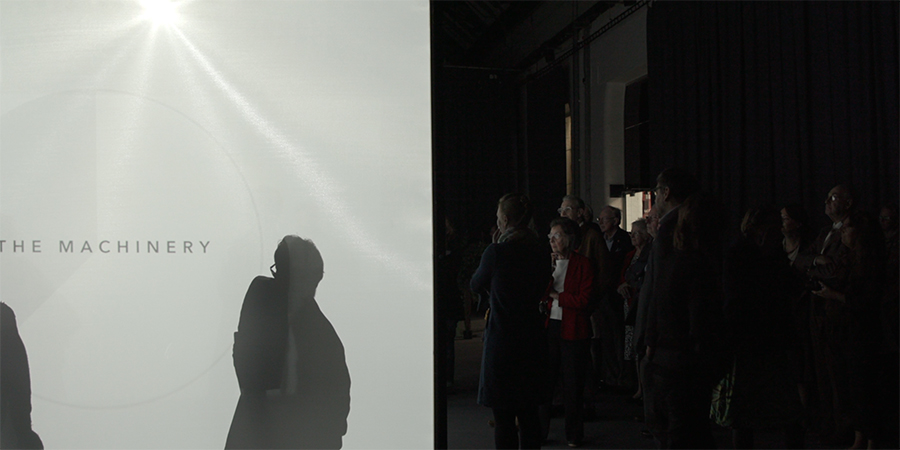The Machinery is a performance for solo dancer and a laptop-based digital artist, devised and performed collaboratively by Caroline Radcliffe and composer and digital artist, Sarah Angliss between 2007 -2018. The Machinery expresses the dehumanisation and alienation of the industrial worker, relentlessly subjected to an exhausting cycle of repetition.

The ‘heel-and-toe’ clog steps are layered with looped sounds taken from Quarry Bank Mill, Styal, a working 19th century cotton mill, and a 21st century call centre, emphasising the connections between the two industries. The performance was awarded a Quake contemporary dance festival award in 2008 and in 2018 The Machinery received Arts Council England funding to develop the work with digital filmmaker, Jon Harrison, into an audio-visual, immersive art installation.
The Machinery – the earliest machine dance
The Machinery is a ‘heel-and-toe’ clog dance passed on Radcliffe by clog dancer, Pat Tracey (1927 - 2008). Born in Nelson, Lancashire, Tracey came from a background of clog dancing that was an important expression of working-class culture in the cotton-weaving mill towns of east-Lancashire. Tracey’s dance steps were handed down to her via generations of her family and originated in the cotton mills of the early nineteenth century.
The Machinery is significant for its direct relationship to the mechanical components and actions of the cotton machines with steps mimicking both their movements and sounds, their names directly describing them - ‘the pick’, ‘the cog’, ‘weaving’, ‘herringbone’, ‘over-the-tops’, ‘two-up-two-down’ and ‘shunts’.
Mill workers tapped their feet in time to the rhythms of the cotton machinery they operated with their hands. They developed these rhythmic patterns and steps into dances which they then demonstrated and shared with their families and community. The machines were predominantly operated by women and by imitating the machines, they found a way to combat the mental and physical constraints of repetitive factory labour and to literally dance with the machines.
The Machinery constitutes a much earlier form of machine dance than previously documented, predating more recent forms, such as the Futurist dances of the early-twentieth century, by over one hundred years. It is also a precursor to later forms of industrial noise music; Detroit techno and the robotic electronica of Kraftwerk.
When Radcliffe originally learnt the dance, as a member of Tracey’s display team, Camden Clog, it was choreographed for six people. Taken back to its original solo context - one dancer immersed by the sounds and images of the machines - The Machinery perhaps reminds us of our own humanity, within our current precarious working environments.
The Call Centre – ‘dark satanic mills’ of the 21st Century
Lancashire ‘heel and toe’ clog dancing is intrinsically connected to steam-powered labour and machines but by using this machine-inspired dance to control a digital arts piece, the performative interface between human machine workers and 19th Century cotton mill machinery is paralleled with today's call-centre computer operators.
A 2003 research report by the UK Health and Safety Executive identified similarities between working conditions in nineteenth-century cotton mills and modern-day call centres. Nineteenth-century concerns about the wage slaves of the cotton mills were reiterated when BBC news compared UK call centres to the ‘dark satanic mills’ of the Industrial Revolution. Many call centres are now situated in what were once the cotton mills of the nineteenth century.
In the call centre, the powerful machinery of the mill has been supplanted by digital technologies. The cotton of the textile mills has been replaced by data that is collected by call centre workers and then digitally processed. But unlike computers, humans cannot work tirelessly for long periods. Despite this, in most call centres, every second of a worker’s day is closely monitored and productivity is often paid by piece work. Mill workers were subjected to a similar system of surveillance and shared many work-related illnesses such as tinnitus, repetitive strain injury and depression with today’s call centre employees.
In the 1860s, during the Union’s anti-slavery blockades of cotton ships during the American Civil War, much of Lancashire’s cotton production was shipped to India. Similarly, much of the emergent UK call centre industry was soon outsourced to India as a way of increasing capital. India provided cheaper labour and increased productivity. The historical and geographical links created by the economic and political relationship between Britain and India and the cotton and call-centre industries are therefore reflected in The Machinery.

The Machinery and the human automaton
The Machinery is possibly the earliest example of the creative expression of alienation and dehumanisation in the industrial workspace. Cotton mill workers in the 19th Century surrendered to the pace of the machine through necessity. Developing the dance gave workers a means of expression by coalescing with the machine, rather than escaping it, addressing the boredom and repetition.
In Das Kapital, Marx and Engels use the model of the English cotton industry to demonstrate the capitalist system, providing the most complete contemporary account of the industry's working conditions. Marx warns against the processes of the perpetuum mobile and the consequent automatisation of the worker; through the institution of longer working hours but with less human fatigue, automatisation was essential to the success of capitalism.
The majority of those operating the machinery were women or children, selected for their apparent tolerance of this repetitive but exhausting work, due to what Marx describes as their ‘more pliant and docile characters’. By examining the working conditions of the Victorian cotton mill, it is possible to understand how and why The Machinery evolved.
Machines were overwhelmingly loud. It was impossible for workers to hear one another speak. Machines were relentless in their ceaseless actions. There could be no pause for social interaction, lest the worker lose pace, impeding the production process and frequently resulting in injury.
The clog dance was a way of simultaneously addressing and embodying monotonous labour and physical repetition. By aligning the body's own rhythm to the otherwise potentially overpowering and alienating noise and actions of the machines. Arguably, in mimicking the machines, the women were embracing, rather than rejecting, their identity as automatised units of production – entities that could be regarded simply as another component in the cotton mill.
The minimalistic dance steps could be viewed as exemplars of the idealised movements described by time and motion theories developed in the early 20th Century. There is no ‘wasted motion’ contained in the steps, predating the theories by a century.
The clog dance might also be viewed as an example of a creative response to the alienating effects of repetitive labour. When conceiving The Machinery, Radcliffe and Angliss wanted to express the de-humanisation of the industrial and post-industrial female worker while simultaneously asking these questions: does the dance represent a celebration of the machine or a surrender to it? And can the dance be seen as an act of defiance, a way of maintaining the body's control, interaction and creativity rather than allowing the body to become solely an extension of capital? The Machinery can therefore be read as an active resistance to the de-humanising force of industrialised labour, a tactical creation by the weak in terms of industrial power relations in order to evade the confines of the work discipline.
The Machinery: an extraordinary example of early modernism
Radcliffe and Angliss have re-contextualised the dance’s history, using it to control a machine that has dominated the 21st Century - the computer. Thus, the performers – Radcliffe performing the clog dance and Angliss operating the computer – work together to create an intermedial space where the real world, occupied by the human worker, and virtual world of the machine are coupled to each other and act in equal partnership.
The extreme, machine-like control, virtuosity and physical endurance of the dance reflect the stamina required to survive repetitive labour in both the industrial and the post-industrial workplace. The connection between performance and machine is reinforced through the performers’ relationships to each other on stage. Caroline's physical embodiment of the machine is controlled and dictated by Angliss’s programming and operation of sensate digital media.
The Machinery evokes the overwhelming power of mechanisation, demonstrating the inseparable connection between the sounds and actions of the textile machines and the operative's body. The stamina required by the dancer in the exhausting, repetitive dance reflects the endurance required by the analogue and digital machine operators of both the 19th and 21st Centuries.
The Machinery was conceived with a desire to escape the historicity often imposed on traditional dance and music, creating instead an original piece of contemporary theatre; the primary aim was to recontextualise clog dancing for a contemporary audience. It could be received as a dance about technology and reappraised as a comment on our post-industrial age.
This approach would enable parallels between the human–machine dynamic in the cotton mill and the modern day call centre. Thus, any elements of the performance – for instance folk costume, music or setting that might historicise The Machinery were stripped away. Rather than presenting it as a folk dance, a clog dance that already expressed extraordinary elements of modernity was further updated, using it to control a machine of the twenty-first century: the digital computer.
The Machinery: the spectre of Marx
In Spectres of Marx, Jacques Derrida introduces a critical theory that is current in many contemporary fields, including the digital music field, in which he argues that Marx will continue to haunt Western society.
It proved impossible to escape the hauntological presence of the clog dance's past with the ‘ghosts’ of capitalism and the Marxist ideologies that are still ‘haunting’ us, thus permeating the performance. The influence of Marx's and Engels's Das Kapital as one of the main concepts behind The Machinery creates an obvious and direct analogy to hauntology.
The mode for mixing digital and analogue technology could also be termed hauntological, although their relationship is also clearly derived from the postmodern use of pastiche and the re-mixing of historical styles. There is a possible analogy to be made with the Steampunk movement because of The Machinery’s references to Victorian technology and hauntological traces.
By acknowledging and directing the spectator to the performance's historical roots, a political statement is made about the condition of the worker in repetitive labour for the benefit of the capitalist.
First and foremost, Radcliffe and Angliss were seeking to demonstrate the positive possibilities of creativity arising from the individual's ability to take control of her condition.
The Machinery: related citations
“In handicrafts and manufacture, the workman makes use of his tool, in the factory, the machine makes use of him. There the movements of the instrument of labour proceed from him, here it is the movements of the machine that he must follow.”
Karl Marx Das Kapital (1867)
“The automaton … is therefore animated by the longing to reduce to a minimum the resistance offered by that repellent yet elastic natural barrier, man. This resistance is moreover lessened by the apparent lightness of machine work, and by the more pliant and docile character of the women and children employed on it.”
Karl Marx Das Kapital (1867)
“To work at a machine, the workmen should be taught from childhood, in order that he may learn to adapt his own movements to the uniform and unceasing motion of an automaton.”
Karl Marx Das Kapital (1867)
“It is questionable if all the mechanical inventions yet have lightened the day’s toil of any human being.”
John Stuart Mill: Principles of Political Economy (1848)